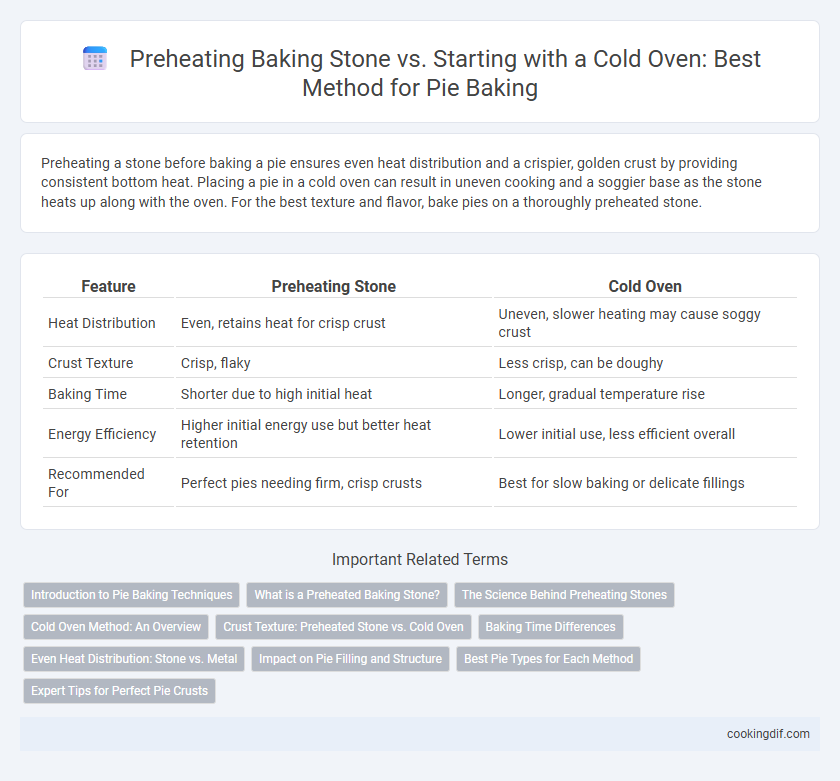Preheating a stone before baking a pie ensures even heat distribution and a crispier, golden crust by providing consistent bottom heat. Placing a pie in a cold oven can result in uneven cooking and a soggier base as the stone heats up along with the oven. For the best texture and flavor, bake pies on a thoroughly preheated stone.
Table of Comparison
| Feature | Preheating Stone | Cold Oven |
|---|---|---|
| Heat Distribution | Even, retains heat for crisp crust | Uneven, slower heating may cause soggy crust |
| Crust Texture | Crisp, flaky | Less crisp, can be doughy |
| Baking Time | Shorter due to high initial heat | Longer, gradual temperature rise |
| Energy Efficiency | Higher initial energy use but better heat retention | Lower initial use, less efficient overall |
| Recommended For | Perfect pies needing firm, crisp crusts | Best for slow baking or delicate fillings |
Introduction to Pie Baking Techniques
Preheating a baking stone is crucial for achieving a perfectly crisp pie crust, as it provides consistent, high heat that prevents sogginess and promotes even browning. In contrast, placing a pie in a cold oven allows the crust to bake more gradually, which may result in a softer, less flaky texture. Utilizing a preheated stone is a favored technique in professional pie baking to enhance crust quality and ensure optimal heat distribution during the baking process.
What is a Preheated Baking Stone?
A preheated baking stone is a thick, heat-retaining slab made from materials like ceramic, cordierite, or cast iron, designed to evenly distribute high heat for baking pies. It absorbs and radiates intense, consistent heat, which helps develop a crisp, golden crust by preventing sogginess from pie filling moisture. Using a preheated stone promotes superior browning and texture compared to placing a pie on a cold oven surface.
The Science Behind Preheating Stones
Preheating a baking stone ensures even heat distribution and rapid temperature recovery, which prevents the pie crust from becoming soggy by quickly sealing its bottom layer. The stone's thermal mass absorbs and radiates consistent heat, promoting optimal Maillard reactions that enhance crust browning and texture. Baking in a cold oven with a stone lacks this immediate thermal shock, resulting in uneven baking and diminished crust quality.
Cold Oven Method: An Overview
Baking pies using the cold oven method involves placing the pie directly into an oven that heats gradually, which promotes even cooking and minimizes crust shrinkage. This technique is ideal for delicate fillings, such as custards or cream pies, as it reduces the risk of cracking or overcooking. Studies show that the slow heat increase allows moisture to redistribute more evenly, resulting in a tender, flaky crust with well-set filling.
Crust Texture: Preheated Stone vs. Cold Oven
Preheating a baking stone before placing the pie in the oven results in a crisper, flakier crust due to the immediate and even heat transfer that promotes rapid dough setting and caramelization. Baking a pie in a cold oven on a stone produces a softer crust with less pronounced browning because the stone gradually heats alongside the oven, causing slower dough cooking and less caramelization. For optimal crust texture, using a preheated stone creates the ideal environment for achieving a golden-brown, crunchy bottom crust.
Baking Time Differences
Baking a pie on a preheated stone reduces baking time by providing immediate, consistent heat that crisps the crust evenly and prevents sogginess. In contrast, placing a pie in a cold oven requires longer baking to achieve the same crust texture, as the stone gradually heats up during the baking process. Studies show preheating the stone can cut baking time by 10 to 15 minutes depending on the pie type and oven settings.
Even Heat Distribution: Stone vs. Metal
Preheating a stone for pie baking ensures even heat distribution, resulting in a consistently crisp, golden crust as the stone retains and radiates heat uniformly. Baking in a cold oven with a metal pan may cause uneven cooking due to the metal's rapid heat conduction and temperature fluctuations. Stone surfaces maintain steady heat, reducing hot spots and promoting thorough baking, which is crucial for delicate pie fillings and flaky dough.
Impact on Pie Filling and Structure
Preheating a baking stone ensures even heat distribution, resulting in a crispier crust and well-cooked pie filling with optimal texture. Baking a pie on a cold oven and stone causes the crust to heat gradually, which can lead to soggier edges and unevenly cooked filling. Precise temperature control from a preheated stone supports better caramelization of sugars in the filling, enhancing flavor and structural integrity.
Best Pie Types for Each Method
Preheating a baking stone is ideal for pies with a crisp, flaky crust like fruit pies and pot pies, as the intense initial heat promotes even browning and a firm bottom crust. Cold oven baking suits custard, cream, and chiffon pies, allowing gradual heat penetration that prevents cracking and curdling while ensuring smooth textures. Selecting the appropriate method enhances pie quality by matching heat application to pie filling and crust characteristics.
Expert Tips for Perfect Pie Crusts
Preheating a baking stone ensures even heat distribution and a crisp, golden pie crust by simulating a brick oven effect that prevents sogginess. Starting a pie in a cold oven often leads to uneven baking and a less flaky texture as the dough warms too slowly and absorbs more moisture. Experts recommend preheating a pizza stone to 425degF (220degC) before sliding in the pie to achieve optimal bottom crust browning and a perfectly flaky finish.
Preheating stone vs cold oven for pie baking Infographic

 cookingdif.com
cookingdif.com